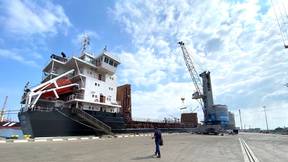Synerglzing snip Repair
Highly industrialized Singapore, embracing little more than 230 sq. mi. of territory off the southern tip of the Malay peninsula, is remarkable on many counts for its industrial endeavors and trading profile. The economic contribution made by its ship repair activities cannot be understated. An estimated 15 floating docks and 15 graving docks, complemented by more than 10 yards involved in specialized ship and rig building, affords an indication of the scale and international influence of the sector.
It possesses the physical and technological capabilities to take on any type and scale of job in the ship repair and conversion domain. While its reputation for contractual performance and good productivity is undisputed, there are limits to its ability to ward off everkeener competition in main sectors of the repair business, including standard drydocking work.
The characteristically forwardthinking approach which has seen Singaporean companies foster and develop shipyard ventures in lower wage cost areas of the Asia Pacific region, has also seen strategies employed on the home front of targeting higher value sectors of the business, investing in scale economies offered by new docks, and relaxing employment restrictions on foreign nationals in Singapore in an effort to ease labor supply problems.
While the ship repair business is essentially short-term in the lead times it involves, and while it is highly sensitive to cyclical shipping market conditions, corporate planners must take a long-term view of operations in Singapore, relative to emerging competition and sectoral industrial development on a global basis.
As a core element of the restructuring process now under way within Singapore's exceptionally heavy concentration of shiprepair facilities and building yards, the merger of Sembawang Shipyard with Jurong Shipyard (JSL) brings a massive combined force into being. Although synergies will be exploited, the new entity can be expected to maintain the two sites for the foreseeable future.
Fluctuations in demand and ever-tougher competition for general ship repair and drydocking work have seen the industry in Singapore successfully develop more specialized lines of business. One such area has been the conversion of tankers for a floating production and storage role. The extent of new opportunities for tapping the resources of smaller or marginal oilfields is likely to ensure continuing demand for such units, although there is an increasing tendency toward newbuild construction. JSL augmented its workload in the offshore sector by taking on the job of adapting the 103,000-dwt Munin, the second of two multipurpose shuttle tanker (MST) newbuildings for a production role on the Lufeng field in the South China Sea. Ordered by Norwegian owners from Samsung Heavy Industries, and offering a storage capacity of 640,000-barrels, the vessel arrived directly from the Koje Island yard in South Korea for installation of processing equipment. Underscoring JSL's successful development of business in a niche market, the 1997 contract intake included the conversion of a VLCC into a 2.2 million-barrel FSU, the upgrading of a floating storage unit (FSU) into a floating production, storage and offloading vessel (FPSO), and the conversion of a Suezmax tanker for a stationary offshore role.
Among the lengthier jobs undertaken by Sembawang last year was the large-scale refurbishment of the 150,500-dwt Vietnamese FPSO Chi Link. The vessel had been adapted for floating production duties in the late 1980s, and the recent refit prepared it for a further period of duty off the coast of Vietnam. Confirming the company's prowess in adapting tankers for offshore duties, Keppel Shipyard recently landed a contract from Singapore-based Nortrans Engineering Group for the conversion of the 141,000-dwt tanker Knock Buie into an FPSO.In its new guise, the 1975-built crude carrier will be deployed by Nortrans on the Ranger oilfield development off Angola, an area of fast growing activity.
Keppel's remit includes the fabrication and positioning of the requisite deck foundations for the process equipment, supplied by the contractual interests for installation by the yard. The transformation work also includes an eightpoint mooring system, aft helideck, bow offloading line and platform, and deck crane and riser porch. Immediately prior to the start of the conversion program, and under a separate contract from Norwegian shipowner Red Band, the yard effected about 100 tons of steel renewal, plus overhaul work and routing drydocking.
Contractual commitments in the offshore vessel category executed by prolific Keppel last year included the fit-for-purpose conversion of the 59,650-dwt tanker Armada Perkasa into an FPSO for duties off the Malaysian coast, and the adaptation of the 70,000-dwt tanker Endeavor as an FSO (floating storage and offloading) vessel.
It also won the $43 million project to convert the 12,000-dwt Peregrine IV into a dynamic-positioning (DP) drillship, due to be completed by mid 1998.
Buoyed by the resurgence of demand in the offshore market, Keppel FELS has extended its workload through 1999 and is pursuing a number of projects in its core business of rigbuilding and upgrading, involving new jack-ups and semi-submersible conversions. With an oversupply situation having given way to a shortage of operational rigs, drilling contractors are now booking rigs as much as two years in advance, stimulating investment in new and rebuilt equipment. Toward the end of last year, Keppel FELS had already secured contracts worth $471 million entailing completions in 1998, with more than $300 million in new orders having been sealed for delivery in 1999. One of the highlights of the inflow of work last year was the award by Santa Fe for the construction of two Universe-class rigs, which will be similar to Galaxy 1, built at the yard for the same owner in 1994. The Caspian Sea, one of the world's oldest oil-producing regions, is among the target markets identified by the company.
While it has established a presence there by providing quality accommodation for oil companies, its March, 1998 ultimate objective lies in supplying drilling contractors working in the growing offshore oil and gas sectors. The Singaporean firm's U.S. subsidiary, Amfels, had around $160 million worth of orders outstanding for completion in 1998-99, as of the end of December. Last year's contract intake featured two newbuilding jack-up rigs.
Keppel FELS' stake in the power business provides a valuable complement to its offshore work, and currently includes the construction of a 100-MW cogeneration plant at Zunhua City in China.
Part of the same owning group, Keppel Marine has four 18,000- bhp anchor-handling tug supply (AHTS) vessels on order for the A.P. Group's Maersk Supply Service. The owner-supplied design features a 350-ton winch. Deliveries are scheduled at threemonth intervals commencing in September 1998.
The first of a new breed of multirole cargo and containership, offering scope for volume production, is set to be handed over this June by Hitachi Zosen Singapore (HZSL). The versatile new Stamford class has been developed by HZSL in conjunction with the GTR Campbellassociated constancy Algoship International, in anticipation of a replacement market for an earlier generation of standard design, general- purpose cargo carriers.
The series of 20,000-dwt geared vessels in hand for the Clipper Group of Denmark, Dockendale Shipping of the Bahamas, and Singapore's own Hai Sun Hup Company hold out the prospect of Singapore's shipbuilding industry fulfilling a role in providing economic substitutes for aging F-class vessels. Built primarily in Japan to Campbell-originated blueprints around 15 to 25 years ago, an estimated 200 such ships remain in service.
One of the results of the recent upgrading of HZSL's facilities is that it can now accommodate an output of one Stamford newbuilding every three months. It has increased its capabilities with a 623 x 131.2-ft. (190 x 40-m) slipway for the construction of vessels up to 30,000 dwt, and has a new outfitting berth. Accreditation to ISO 9001 quality standards adds a further string to its bow in its commercial endeavors.
The competitively-priced Stamfordtype vessel from the Japanese-owned yard has a four-hold configuration with total 23,880-cu.-m. and 23,795- cu.-m. grain and bale capacity measurements, respectively, plumbed by three 36-ton deck cranes. The design has been conceived for bulk commodities, steel products, lumber and unitized forestry goods, or for a full container load of 869- TEU, employing both hold and weatherdeck stowage. Anticipated fuel consumption is 24.2 tons per day at 15 knots on the 30-ft. (9.2-m) design draft.
Singapore Technologies Shipbuilding & Engineering (STSE) is undertaking a further stage of modernization of its yard, which includes two floating docks, through the installation of a new shiplift facility. Its existing Syncrolift of 5,000-tons capacity is around 25 years old. As the marine arm of a diversified industrial group, STSE covers a whole range of sectors in the military and commercial vessel markets, including design, repair, reconstruction, newbuilding and fabrication.
Its recent work inflow has included comparatively long refit and repair contracts involving two tugs owned by Semco Salvage & Marine. The turnkey-type project on Sea Lynx and Sea Panther includes steel and pipe renewals, electrical and mechanical overhauls, upgrading of accommodation and air-conditioning, and hull re-coating.




